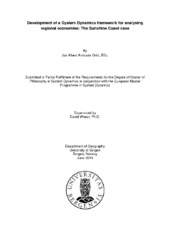| dc.description.abstract | Policy Makers and stakeholders of the Sunshine Coast are aware of the significance of the current juncture, in which the performance of the economy has been deteriorating over the last years. Consequently, the status quo or laissez-faire is no longer an option and actions must be taken. The result of such acknowledgement is a set of pathways to significantly improve the performance of the local economy over the next 20 years by the support of five game-changer projects and seven key high-value industries proposed in a strategy known as the The Sunshine Coast Economic Development Strategy". System Dynamics Group at University of Bergen and Sunshine Coast's stakeholders agreed to assist in the analysis and evaluation of The Sunshine Coast Economic Development Strategy" by the means of a System Dynamics quantified simulation model. The purpose of the simulation model is defined as being a tool that provides a framework that accounts for the performance of local economy, and wherein improvement proposals such as the ones contained The Sunshine Coast Economic Development Strategy" can be assessed. The modelling process is carried out in an incremental and iterative fashion. The iterative process can be seen as the construction of prototypes likely to be enhanced in a next iteration. As a result, two prototype models are developed. The first prototype consists of a disaggregated demographic structure that accounts for the dynamics of the population and labour force, and a basic structure that represents employment and overall productivity. This prototype is used to unravel the causes of the deterioration in the Sunshine Coast's economy. The second prototype integrates the concept of aggregated demand by incorporating a structure that breaks down the economy into 19 industries at division level based on the Australian and New Zealand Standard Industry Classification (ANZSIC). In addition, tourism concept is clarified in the context of the economy and linked to the model. The result is a tool that allows the analysis and evaluation of improvement proposals. | en_US |
